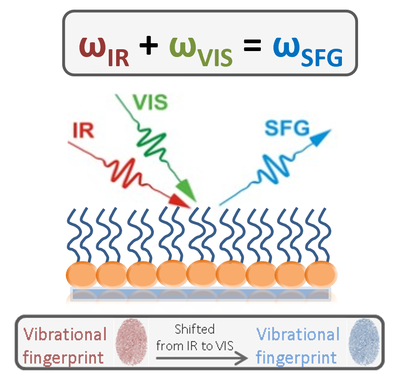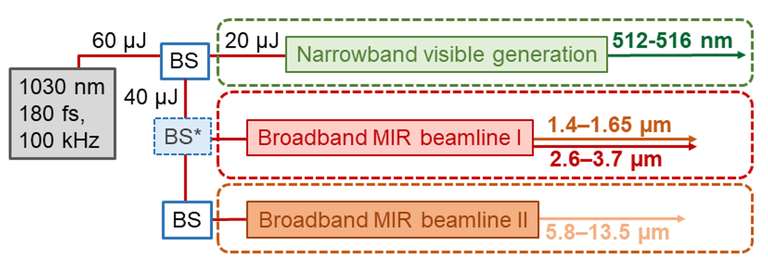Projects
Vibrational sum-frequency generation spectroscopy
Understanding interfacial chemistry and structure is critical in many important applications ranging from surface functionalization chemistry, electrochemistry, heterogeneous catalysis to complex cell biology. Our group is interested in how biological molecules interact with other organic and inorganic molecules at interfaces.
Vibrational sum-frequency generation spectroscopy (VSFG) is a powerful interface specific, non-destructive, and label-free analytical tool to investigate composition, structure, orientation, and dynamics at surfaces. In a broadband VSFG experiment, a narrowband visible and a broadband mid-infrared laser pulse are spatially and temporally overlapped at a surface. The resulting vibrational fingerprint is up-converted from the mid-IR to the visible spectral range through sum-frequency generation (Figure 1). This process is highly enhanced if the infrared pulse is resonant with the vibrational modes of the investigated interface. From the resulting visible spectra, the amplitudes, spectral widths, and frequencies of surface molecular vibrations can be extracted, indicating the composition and orientation of the interfacial species.
 |
Figure 1. Scheme of the vibrational sum-frequency generation spectroscopic method.
In our laboratory, we recently constructed the first broadband VSFG spectrometer operating at a laser repetition rate of up to 100 kHz to improve the sensitivity of this spectroscopic tool. In addition to the high repetition rate, the source also exhibits high power stability and excellent beam quality. The home-built light source consists of (i) a continuum-seeded, multi-branch optical parametric amplifier system providing few-cycle pulses in the wavelength region of 2.7 - 13.5 µm (corresponding to 780-3800 cm-1) and (ii) a sum frequency generation stage providing transform-limited narrowband, picosecond pulses at ~515 nm (Figure 2). The system is currently unparalleled not only due to being the first broadband VSFG system operating at a variable repetition rate up to 100 kHz, but because (i) it is way more compact, robust, and cost effective than a typical system based on Ti:sapphire technology and (ii) it provides an unprecedented combination of broadband, single-shot coverage (800 cm-1) with high spectral resolution (3 cm-1). The higher repetition rate of the source compared to typically employed laser systems offer great potential for providing the boost in sensitivity required for a broader range of applications including time-resolved experiments and scanning microscopy.
 |
Figure 2. BB-VSFG light source. BS: beam sampler, *: flipping option. The broadband MIR beamline I produces few-cycle, tunable two-color beams around 1.5 µm and 3 µm, while the MIR beamline II operating between 5.8 and 13.5 µm.
The available light sources are coupled to our unique VSFG spectrometer. By employing, for the first time, a high-repetition-rate diode-pumped Yb-based laser-amplifier system to drive such a spectrometer, the collection of vibrational spectra of biologically relevant monolayers and bilayers at air-solid and air-liquid interfaces has become possible at an unprecedented combination of signal-to-noise ratios and acquisition times at wavelengths up to 13.5 µm. The main research direction of our group is the investigation of structure-function relations at biological interfaces, including membrane model systems and biomacromolecules, in real time and in situ.
Selected publications
Light source development
Applications at biological interfaces
